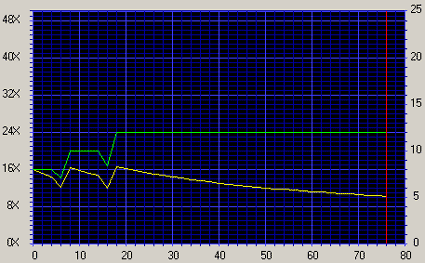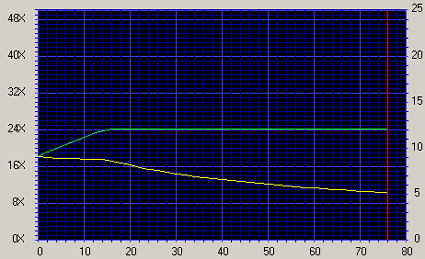Eleven 20x/24x CD Burners
P-CAV And Z-CLV
Before 16x and 20x burners existed, the issue of CD-R writing methods was never raised. Everyone used the CLV (Constant Linear Velocity) mode, where burning starts and ends at the same speed, without ever changing. But, as with CD players, this method has its limitations. In CLV mode, the burner motor has to run very fast right from the start of recording, meaning a large number of revs per minute. If the motor runs very fast, the burner is noisy and the recording is less stable and not very consistent. Furthermore, a start at 24x could be troublesome for a direct CD-to-CD copy. So a more reliable and flexible method had to be invented in order to attain high speeds without affecting the quality and ease of the operation.
There are two opposing methods here: P-CAV, used by Yamaha, and Z-CLV, used by most other manufacturers. The diagrams below illustrate the two methods perfectly. The green line represents the recording speed, and the yellow line represents the number of revs per minute.
You can see that P-CAV (Partial Constant Angular Velocity) starts writing at 16x and increases the speed regularly, until it stabilizes at 24x after 15 minutes of CD-R time. So, the first 15 minutes are run at CAV, i.e., non-constant speed, and the writing ends at CLV at 24x. No tricks are involved, and this is the more flexible method of the two.
Z-CLV (Zoned Constant Linear Velocity) works in stages, as you can see from the chart below. It starts writing at 16x CLV for the first 6 minutes of CD time, then 16x again, still in CLV, and then it changes speed to reach 24x after 16 minutes. These speed changes are very apparent in the chart and are the result of Burn-Proof technology. There is a very brief stop and start, creating a gap, at each point where the burner changes speed.
Get Tom's Hardware's best news and in-depth reviews, straight to your inbox.
Current page: P-CAV And Z-CLV
Prev Page Anti-Buffer Underrun Technologies Next Page The Right Speed For The Right Results
